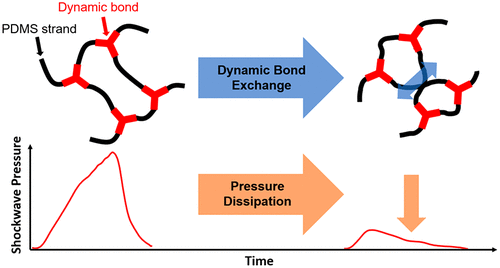当前位置:
X-MOL 学术
›
Macromolecules
›
论文详情
Our official English website, www.x-mol.net, welcomes your
feedback! (Note: you will need to create a separate account there.)
Shock Wave Energy Dissipation in Catalyst-Free Poly(dimethylsiloxane) Vitrimers
Macromolecules ( IF 5.1 ) Pub Date : 2020-06-14 , DOI: 10.1021/acs.macromol.0c00784 Jaejun Lee , Brian B. Jing , Laura E. Porath , Nancy R. Sottos , Christopher M. Evans
Macromolecules ( IF 5.1 ) Pub Date : 2020-06-14 , DOI: 10.1021/acs.macromol.0c00784 Jaejun Lee , Brian B. Jing , Laura E. Porath , Nancy R. Sottos , Christopher M. Evans

|
Materials that absorb shock wave energy from blasts and high-speed impacts are critical for protection of structures, vehicles, and people. Incorporating dynamic bonds into polymers has enabled precise control over the time-dependent response and energy-dissipating modes, but this work has focused on much slower time scales and lower forces than those associated with shock waves. Here, we design polymers networks with dynamic covalent bonds, called vitrimers, where reversible exchange reactions provide a potential mechanism for shock wave energy dissipation. Increasing the density of dynamic bonds leads to a systematic increase in energy dissipation, measured by the drop in peak pressure of a laser-induced shock wave. An analogous permanent polymer network shows no dependence of dissipation on cross-link density. The vitrimers can absorb shock multiple times while maintaining performance, attributed to bond exchange and the intrinsic self-healing ability of the polymer. Our results are the first to demonstrate that vitrimers are an effective route to the design of energy-dissipating materials, particularly at the high frequencies and pressures associated with shock waves.
中文翻译:

无催化剂的聚(二甲基硅氧烷)三元共聚物中的冲击波能量耗散
从爆炸和高速冲击中吸收冲击波能量的材料对于保护建筑物,车辆和人员至关重要。将动态键结合到聚合物中可以精确控制与时间有关的响应和耗能模式,但这项工作的重点是与冲击波相比更慢的时间尺度和更低的力。在这里,我们设计了具有动态共价键的聚合物网络,称为vitrimers,其中可逆交换反应提供了一种潜在的冲击波能量消散机制。动态键密度的增加导致能量耗散的系统性增加,这是通过激光诱导的冲击波的峰值压力下降来衡量的。类似的永久聚合物网络显示出耗散对交联密度的依赖性。由于保持了聚合物的键交换和内在的自愈能力,因此三聚体可以在保持性能的同时多次吸收冲击。我们的结果首次证明,微晶陶瓷是设计耗能材料的有效途径,特别是在与冲击波相关的高频和高压下。
更新日期:2020-06-23
中文翻译:

无催化剂的聚(二甲基硅氧烷)三元共聚物中的冲击波能量耗散
从爆炸和高速冲击中吸收冲击波能量的材料对于保护建筑物,车辆和人员至关重要。将动态键结合到聚合物中可以精确控制与时间有关的响应和耗能模式,但这项工作的重点是与冲击波相比更慢的时间尺度和更低的力。在这里,我们设计了具有动态共价键的聚合物网络,称为vitrimers,其中可逆交换反应提供了一种潜在的冲击波能量消散机制。动态键密度的增加导致能量耗散的系统性增加,这是通过激光诱导的冲击波的峰值压力下降来衡量的。类似的永久聚合物网络显示出耗散对交联密度的依赖性。由于保持了聚合物的键交换和内在的自愈能力,因此三聚体可以在保持性能的同时多次吸收冲击。我们的结果首次证明,微晶陶瓷是设计耗能材料的有效途径,特别是在与冲击波相关的高频和高压下。











































 京公网安备 11010802027423号
京公网安备 11010802027423号